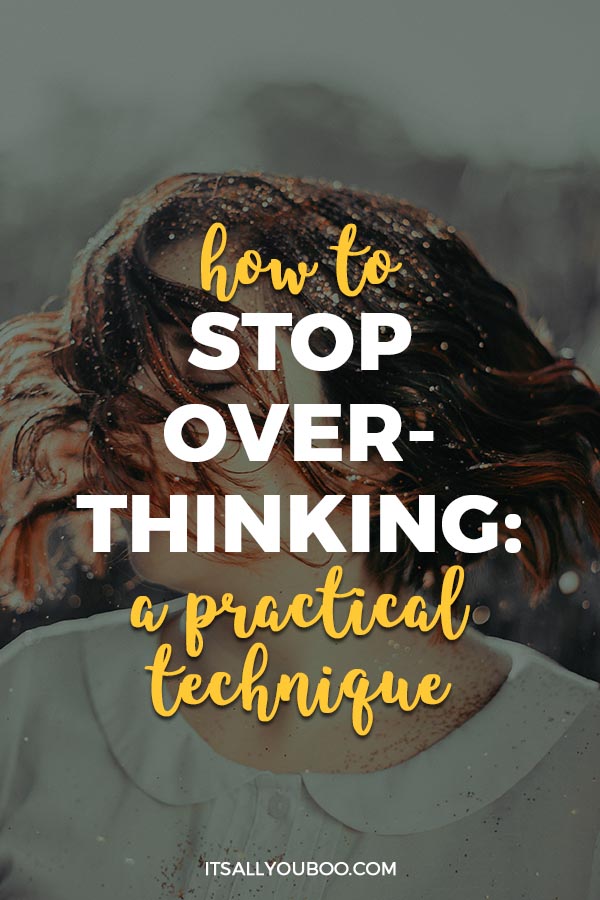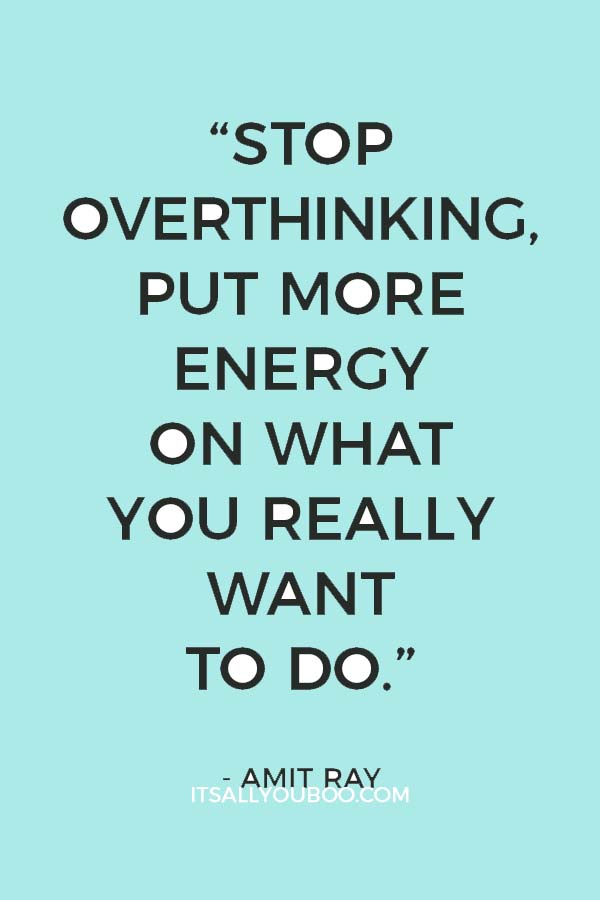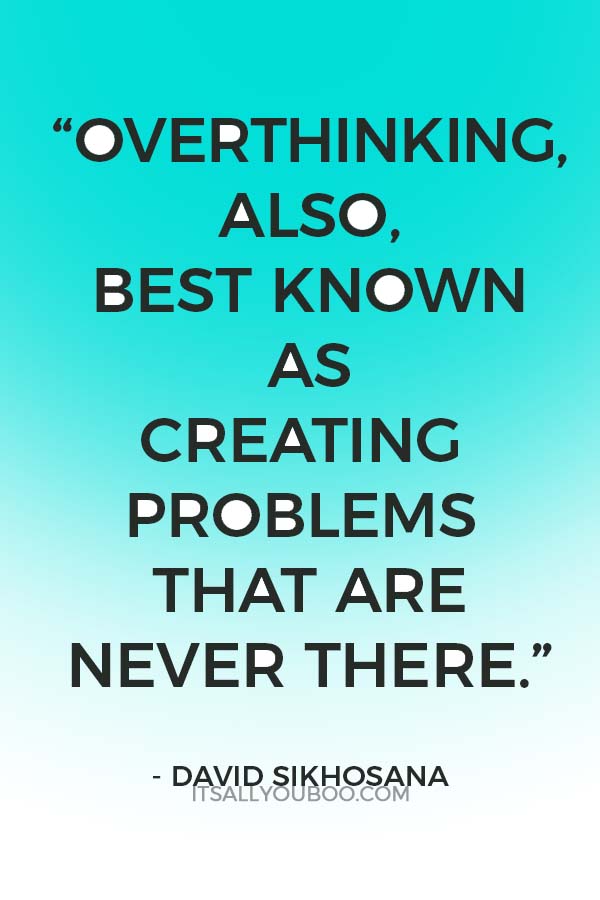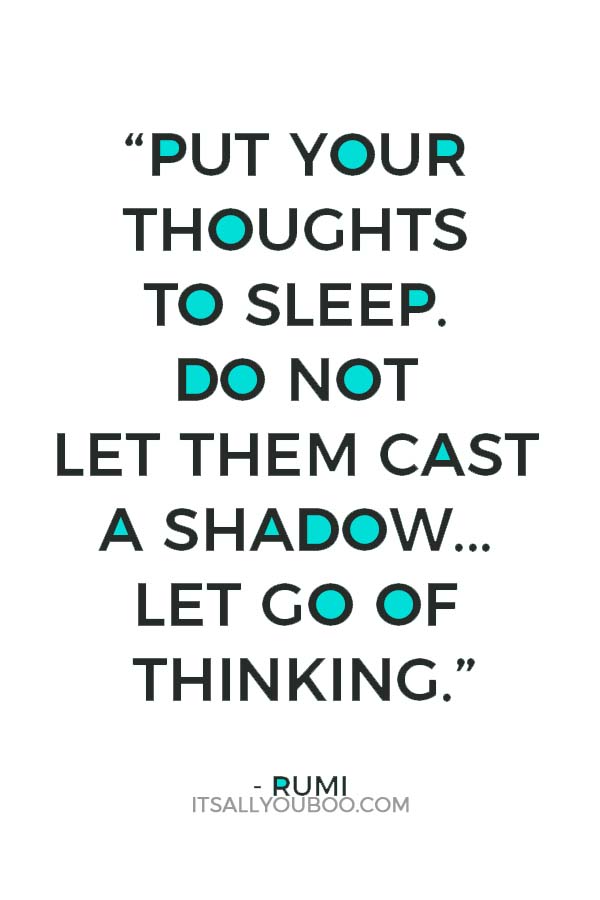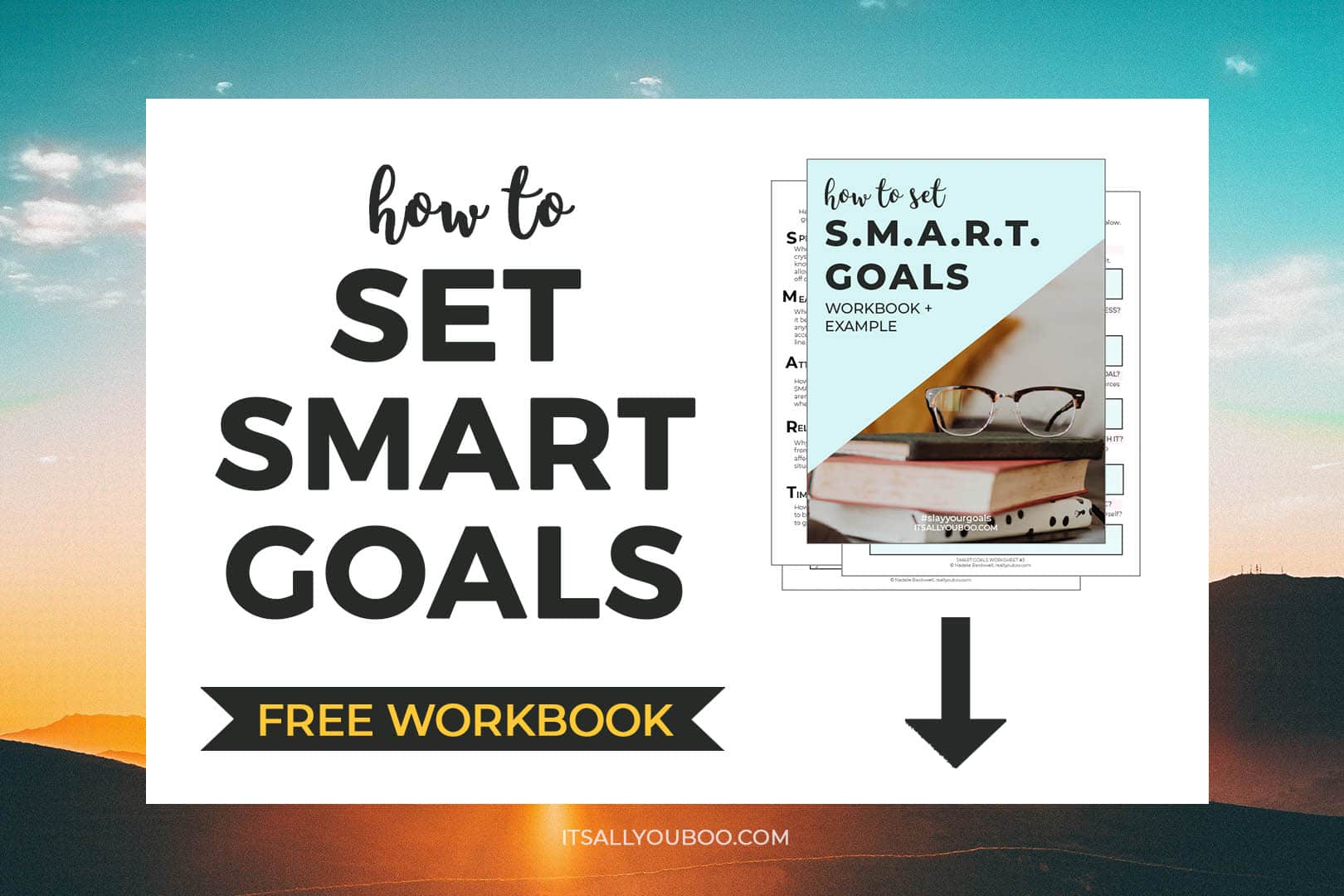What do you do when you can’t shut your brain off?
Do you wonder, why can't I stop overthinking everything? Here a simple technique to quiet your mind. #mindfulness #peace
Apparently, overthinking doesn’t sound so bad – thinking should be a good exercise for the brain, right? But it can actually cause quite some problems.
Overthinking is as debilitating as it is common. It can ruin your social events, disturb your sleep, undermine your job performance, ruin your vacations and generally stop you from enjoying all the other great things that come into your life every day.
When you overthink, your thoughts and judgments get cloudy; while your stress levels get elevated – not to mention you tend to spend too much time in a negative mindset. Typically, it also comes with all the physical discomforts of anxiety, which means that overthinking leaves you not only mentally distressed but also physically exhausted.
Luckily, there is good news in this picture, too.
Table of Contents:
The first thing you need to know is that stopping yourself from overthinking is possible.
You don’t have to feel like this all your life! But apart from suggesting you to meditate daily and breath deeply as often as you can to calm your nerves and slow down your heart rate; today I want to propose you a practical technique that will come in handy whenever you need to stop overthinking about particular big projects (or why not even dreams!) you want to get done.
In other words, this technique will help you sweat much less while worrying about the many steps or different things that you need to do in order to accomplish a much bigger task (e.g write a book, start a business or even plan a trip).
THIS POST MAY CONTAIN AFFILIATE LINKS.
IF YOU MAKE A PURCHASE FROM THESE LINKS, I MAY EARN A SMALL COMMISSION.
CLICK HERE FOR MY FULL DISCLAIMER STATEMENT.
The One-Page Strategy to Stop Overthinking
What we’re gonna talk about is also considered an extremely powerful productivity and planning technique: it’s called the one-page strategy.
It will help you clear the thoughts in your mind when you feel like there’s too much on the plate (for a business or personal project).
I found it useful many times in the past (I read that Tim Ferriss used it to learn the Japanese alphabets and that Ramit Sethi – from I Will Teach You to be Rich – used it as well for writing his book!)
I think sometimes we feel overwhelmed because ‘we have it all everywhere’ meaning that we spread our ideas on post-its, different pieces of paper and on the phone instead of having them in one single place. This might make you feel stuck (sometimes lack of clarity is the cause of procrastination) and cause you to give up even before starting.
If you stop overthinking, you can also stop procrastinating!
There’s something about seeing all your ideas on one page and being able to zoom it all out – no matter what it is (business, goals, productivity, accounting etc.) – that makes this an extremely effective method.
It’s also been proven that planning ahead improves productivity and that your chances to accomplish something in the less amount of time possible radically increase with good planning. In other words, you’re much more productive if you know where you’re going.
What Can This Method Do For You?
Just think of it for a second. You will spend waaay less time worrying about the end result (fearing that you’re wasting time or efforts – if you’ve heard that constant, annoying voice in your head repeating ‘you’re gonna fail, this is not working’ you know what it feels like) if you know exactly why you’re doing what you’re doing. And this might sound common sense at first but bear with me.
Anxiety, fear, procrastination etc. will come and haunt you when you don’t know what you’re doing, or where you’re trying to go. I mean, c’mon! We naturally procrastinate on things we’ve never done before or consider hard to do (you would rarely procrastinate on washing your teeth, for instance, because it’s a simple task you do every day!)
But that’s when clarity comes to the rescue. Clarity of ideas will lead to clarity in action. And that will save you tons of hours procrastinating. Simple as that.
Let’s make an example. Let’s say you’re planning to launch your freelance business online and you need to do some cold emailing to get your first clients. This can be a huge process, but we can chunk it down so that it doesn’t appear as intimidating.
First, you’ll collect some contacts, you’ll open your email, then you’ll start brainstorming until you can create a guideline on what you want to say.
See? It sounds a lot less scary. Now, it’s even doable. Did it save you time procrastinating? Hell yeah!
Also, sometimes if you’re feeling overwhelmed with something, it’s probably because you have a little bit here and a little bit there. Just knowing where things relieve the stress and the clutter (but we’ll get more deeply into that in a few minutes!).
Examples of What You Can Do With the One-Page Strategy
Here are some ideas on what you can use this technique for:
-
To plan your new year’s resolutions/goals:
This technique can particularly come in handy when you’re planning – but it will also be helpful to stick to – your new year’s resolutions.
Whether you want to drop a few pounds, spend more time with your family, take a new class – or whatever else it is that you want to accomplish this year (the possibilities are unlimited!) – this type of planning will take you there.
-
To plan your book (content + structure):
If you’ve always said you wanted to write a book sooner or later, here’s the right way to do it. Writing a book can and will feel overwhelming. Whether you want to write something fictional or not, it has to have some kind of organization at some point.
If you just expect to start writing random stuff and that it will magically come in the form of a book, good luck with that! Instead, this technique can be a good method to put some order into your mind (and pages!)
-
To plan your life:
Here you can include your purposes, your long-term goals, and even your bucket list.
-
To plan your business roadmap:
There are few things in life as hard as starting your own business, especially if it’s your first try. In one way or another, you will need to follow some sort of direction – and this technique will give you exactly that.
-
To plan basically, everything else that comes to your mind:
Whether it’s a long, relaxing holiday week with your family, or a complete declutter of your closet, there’s always a way this strategy comes in handy to clear and organize the thoughts in your head.
Now let’s finally see what exact steps you’ll need to take in order to make the technique effective.
How to Stop Overthinking with the One-Page Strategy
Step #1: Brainstorming + Putting It All Together
Collect all the notes you wrote on your phone and the million post-its you left attached on your computer and write it all down on a new piece of paper. I suggest you use a notebook so that you actually have limited free space to write (I think it’s way harder to do this in a digital form but you choose!).
Whenever possible, try to create connections, for example between related actions.
Also, try to keep a chronological order between the ‘to-dos’ as much as possible (although this is not mandatory) – or it might get too messy again during the next step of the process.
After that, brainstorm all the further little action steps that you would need to meet in order to reach your goal.
For example, if you want to redesign your website, you would either have to search for a theme that you like, and if you can’t find a theme you might have to find a web designer and web developer and before you even get into that, you probably should decide a color palette or gather some photos for inspiration (this is basically why I find myself on Pinterest all the time!).
So you get the point here: word-vomit and brainstorm all the steps that come to your mind when you think of what you need to do in order to reach a specific goal or carry out a specific project of yours.
Try to also keep in mind that there might be different ‘roads’ to follow to get the same result – so don’t forget to add alternatives as well. In this phase, you slightly need to edit anything thus let your mind run free of possibilities and different ways to achieve the same goal.
Putting order to this mess is the second exact step.
Step #2: Put Some Order to Your Mess
After brainstorming and putting all our ideas together, a little declutter is mandatory in order to make things clearer and start acting upon them. Remember: when there’s clarity, we’re less likely to spend time procrastinating – and this why this second step is so crucial.
HOW:
Prioritize and Identify your ‘Cores’
So after you kind of word vomit all of the to-do list items that you know you will eventually need to get done; list them out, this time in chronological order.
- Take action: Circle the three most important tasks that need to be done, with the first one being an absolute priority (this means it is both important and urgent, or in general it’s what would make a huge difference compared to others).
- Then, take those three ‘to-dos’ and schedule them in your Google calendar (or planner, or whatever else you use!), giving them also a deadline.
- After you accomplish those three steps, go to your notes again, pick the next three important items and transfer/schedule them into your to-do list. Keep doing so until all of your items are done.
In this process, setting a deadline – an ideal date you’d like to reach that goal for – is crucial. And it should not only be set for the project itself, but also for each individual task on your to-do list. I learned with time and experience that if I don’t set a deadline I will just be relaxed and lazy and not work on it till I’m forced to.
👉🏽 RELATED POST: How to Crush Your To-Do List
It’s also especially important to set a reward for each of those deadlines. For doing so, keep in mind this general rule: the harder the task, the bigger should be the reward. Each reward should be something that you genuinely enjoy doing, or that even excites you like a child.
For example, I love (so much!) going out for dinner, but I save it for special occasions, to both motivate me and save money at the same time. So when I have a big project I’m working on, I plan a night out to celebrate with my friends and family in my favorite restaurant if I meet a certain deadline.
By doing so, I find myself being so much more productive. This happens mainly because when I feel down or tired the image of me having fun with my family and friends keeps me motivated. Indeed, setting rewards for your deadlines are known to keep your levels of willpower high for longer.
Consider circumstances
In an ideal world, we would do everything we set our mind to, everything we write down in our to-do list.
Unfortunately, this does not always happen. Why? Life gets in the way. You get busy, distracted and sh*t happens. You can’t just expect everything to go according to plan.
So, when writing down your plan all on one page, try to also consider everything that might come in your way.
Sometimes being productive doesn’t only mean being able to meet deadlines or sit down and work for many hours; it can also mean taking control back as fast as possible when emergencies and setbacks occur.
👉🏽 RELATED POST: 3 Major Obstacles to Success You Need to Avoid
Step #3: Make It S.M.A.R.T.
Now, we’re basically gonna review all the items we put on our list and see if those are achievable and specific or, in other words, if they are ‘SMART’ enough to be worth our time and efforts. Consider this to be a ‘proof’ or final test to make sure you’ll be working effectively. This section is all about making your plans as actionable as possible.
How to spot ‘SMART’ Goals
Let’s verify the goals you have set (that will all together help you put your plan into action) follow the very well-known SMART method.
This basically means that every to-do item on your ‘one page’ must be:
- Specific,
- measurable,
- ambitious,
- realistic and
- timely.
Let’s make an example. Let’s say my big goal is to “become a business owner”. Is this a ‘SMART’ goal? Partly. While it’s both ambitious and realistic, this intention is not specific nor measurable or timely.
Instead, “Start a blog and sell online courses on how to practice yoga by 2020” looks much more attainable and specific – and classifies as a SMART goal.
- Take action: Start with selecting up to three goals and be sure each can be assigned the ‘SMART’ status. If one of your goals doesn’t follow the rules, delete it.
Remember, you should be able to always come back to this plan in the future to keep yourself motivated and laser-focused. That’s why you need to give clear instructions to your brain from the start!
👉🏽 RELATED POST: Intro to SMART Goal Setting for Your Passion Project
Some Other General Advice Your Might Find Helpful
- Select the hardest and most time-consuming tasks and do them first.
- Try to batch similar activities together, to get workflow easier.
- Try to always consider a B-plan, or an alternative road to get what you want (and trust me, there’s always at least one).
- Use time-bounds and deadlines, but be realistic with those.
Take action: Track three small columns into your ‘one page’:
- things you can do today,
- things you can do tomorrow,
- things you can do the day after that
Then, insert at least three actions into every column.
By making sure your one-page strategy is also SMART, you’re prepared and can stop overthinking.
Step #4: Make It Pretty
Appearance isn’t everything – and you should never judge a book entirely by its cover – but a good design can help things flow more smoothly, especially in the beginning. Eyes must be fed too after all, right? An idea would be to realize some decorations and drawings (nothing too elaborate or extra if you’re not good with that!) on the one page or – in the worst case scenario – to simply add some color.
You can find countless DIY design ideas on Pinterest; try searching for ‘bullet journals’ and take inspiration from there. If you like a template or an image, you can always print it out so that you’re not even forced to do anything by hand.
👉🏽 RELATED POST: How to Start a Bullet Journal: A Beginner’s Guide
This will not only make your page aesthetically pleasing but will also make sure you’re happy to check it out more frequently.
Quiet Your Mind from Overthinking
What I’ve found is that sometimes generating too much information over too long of a timeframe results in flat-out overwhelm (which is exactly what we’re trying to avoid, aren’t we?).
That’s why the “plan on a page” should be used, reviewed and updated in time. It should push you to think, be decisive, and be honest about what’s really important, making sure you don’t paralyze yourself from taking action. And most importantly (yes, I’ll repeat it once again!) it should be actionable in.the.present.moment.
In the end, it doesn’t really matter how much you plan if you’re doing nothing but that! So try to make this page fit in nicely with broader long-term initiatives as a way to keep the momentum going.
Finally, I’d like to invite you not to be skeptical and give this process a try — it should take an hour maximum of your time. I really hope you enjoyed reading this article as much as I enjoyed writing it – and that you’ll find this technique useful. Keep killing it!
If you liked this technique useful or want to share other productivity tools you used in the past, feel free to do so in the comments section below!
👉🏽 RELATED POST: 12 Easy Ways to Spring Clean Your Mind
Your One-Page SMART Goals Worksheet
Ready to stop overthinking your goals? Do a brain dump by making sure your goal is S.M.A.R.T. Sign up below to get your FREE Smart Goals Worksheet, it’s both form-fillable and printable.
How do you stop overthinking?

More About Guest Contributor
Celeste is the creator and writer of Where Comes The Sun. She loves writing about health, self-improvement, goal setting and anything that can improve a person’s life. Her motto is: “Done is better than perfect” and her favorite things are: her blog, her dog (a Bernese) and pizza!
Last Updated on July 26, 2024
